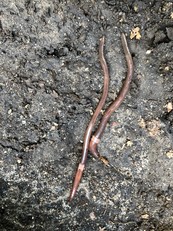Sprigs of scientific discoveries for natural resources managers
|
|
|
Volume 11- April 2023
Forest Health and Invasive Pests
It is that time of year when we eagerly anticipate the first green buds emerging from winter hibernation and yearn for walks in the lush, green forests of Minnesota. In daydreaming about upcoming adventures in the woods, it is important to stay informed about the threats to Minnesota’s forest health and the role we can take in minimizing damage from invasive pests and disease. This issue of the Reader highlights the disruptive nature of invasive earthworms and fungal pathogens, declines in and approaches to restore butternut populations, and the 2022 annual forest health report.
Stay informed! There is so much more to learn about forest health and invasive pests, including experimental buckthorn control measures, understanding what may be attacking your oak trees, and interesting insight about jumping worms. Speaking of worms, the fishing opener is around the corner, and this is a great time to remember to not dump your bait but rather dispose of it in the trash. Thanks for doing your part in protecting Minnesota's forests.
---
The Minnesota Research Reader is a collaboration between the Minnesota Department of Natural Resources and the U.S. Department of Agriculture Forest Service that provides a quick look at emerging research relevant to our work in the State of Minnesota. We hope you enjoy the selection of articles in this month's edition of the Reader!

In this 2019 article, Lee Frelich, director of the University of Minnesota Center for Forest Ecology, leads an exploration of the ecological cascades emanating from non-native earthworms throughout the world. The cascades include fundamental changes (microcascades) in soil morphology, bulk density, nutrient leaching, and a shift to warmer, drier soil surfaces with loss of organic horizons. The diversity of cascade effects, combined with the vast area invaded by earthworms, lead to regionally important changes in ecological functioning.
Management Implications:
- Non-native earthworms speed up decomposition of leaf litter and soil mixing in the upper horizons, leading to loss of the litter layer and higher bulk density.
- These changes in soil structure lead to warmer, drier soils and changes in nutrient availability.
- Resulting cascade effects of concern include changes in CO2 sequestration, disturbance regimes, soil quality, water quality, forest productivity, plant communities and wildlife habitat, and facilitation of other invasive species.
|

Eric Otto, forest health specialist at the Minnesota Department of Natural Resources, conducted his PhD research at the University of Minnesota on the fungus Heterobasidion irregulare. This is one of the most problematic forest pathogens in the northern hemisphere. Discovered in Wisconsin in 1993, it quickly spread throughout the state. In 2014, it was found in southeastern Minnesota. This pathogen causes Heterobasidion root disease, which primarily affects red and white pine in north central North America. Part of this research involved detecting H. irregulare with different methods including the use of spore traps.
Management Implications:
- Spore surveys were demonstrated to be an effective tool for pathogen detection. The quantity of spores found in this study, however, was low. Thus, preventive management for Heterobasidion root disease is not currently warranted in Minnesota.
- However, cautious landowners can still treat pine stumps with a registered fungicide after thinning, to prevent infection to residual pines.
- Spore surveys should continue for Heterobasidion irregulare. When spores trapped reach a quantity of concern, this can indicate that stump treatment is needed.
|

Researchers from the U.S. Forest Service published this study that describes how the butternut hardwood species is negatively affected by three big problems: Typical land management practices in the stands in which they occur, widespread hybridization with Japanese walnut, and butternut canker disease. The paper offers an update on conservation practices throughout the range of the species and describes a strategy for canker-resistance breeding in butternut using naturally occurring hybrids, hybrids in research orchards, and sources of native trees from as many regions as possible.
Management Implications: Researchers are soliciting help from the forestry community to take these steps to help save butternut (a Minnesota endangered species). Note that collection, propagation, and planting of butternut in Minnesota can only be done under the authority of an endangered species permit from DNR.
- Collect butternuts to propagate and feature in botanic gardens and arboreta.
- Upload images and locations to TreeSnap, a free mobile phone application developed by scientists at the University of Kentucky and University of Tennessee, so the trees may be used for future breeding efforts.
- When appropriate to the site conditions and location, include butternut in upland plantings with high light environments, especially on sites that can be protected from white-tailed deer.
- Collaborate with researchers, nonprofit organizations and breeders to develop actionable knowledge—for example, to improve the canker-resistance screening process and to understand the pathogen’s biology.
|

The annual forest health report provides information about significant damage to forests recorded in aerial and ground surveys. The report is of special interest to foresters who can use it to learn what is threatening forests they manage. Minnesota DNR Forest Health staff collaborated with the U.S. Forest Service to aerially survey about 17.4 million acres of Minnesota for damage to forests.
Management Implications:
- Eastern larch beetle infested more acres than ever before in the state, exceeding 300,000 acres.
- Spruce budworm damaged just shy of 500,000 acres, mostly in northeast Minnesota. That’s the most damage reported since 1995.
- Introduced basswood thrips severely damaged patches of basswoods from central to north central Minnesota for the second year in a row.
|
|
|
|
Photo credits from top: Minnesota Department of Natural Resources, The University of Minnesota, Minnesota Department of Natural Resources, Minnesota Department of Natural Resources
|
|
Please sign up for future editions and feel free to share with others!
Subscribe to the newsletter and visit our website for archived issues.
|
|
|
|